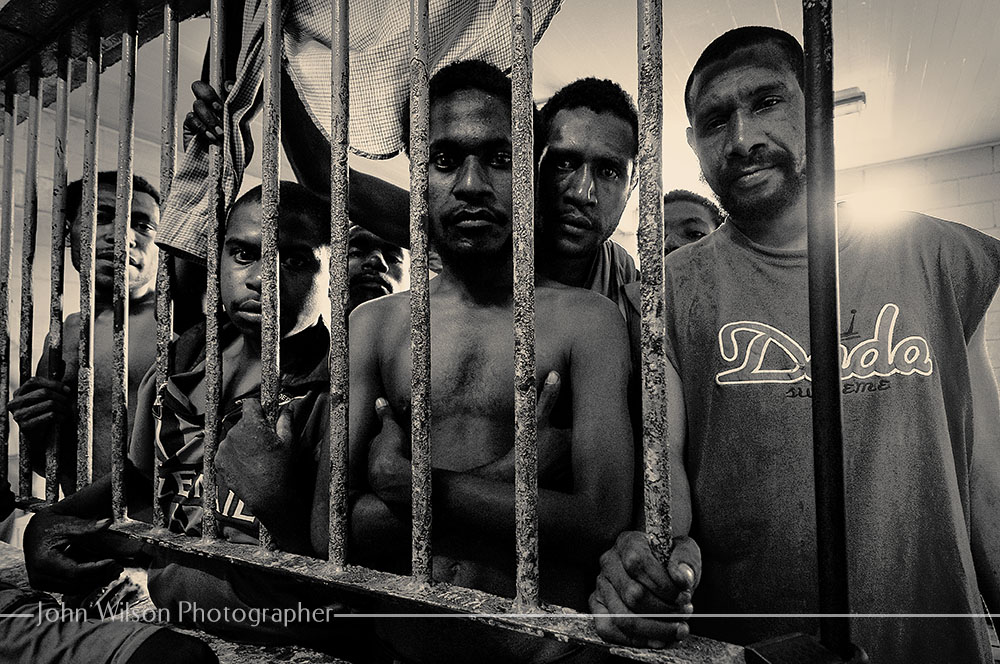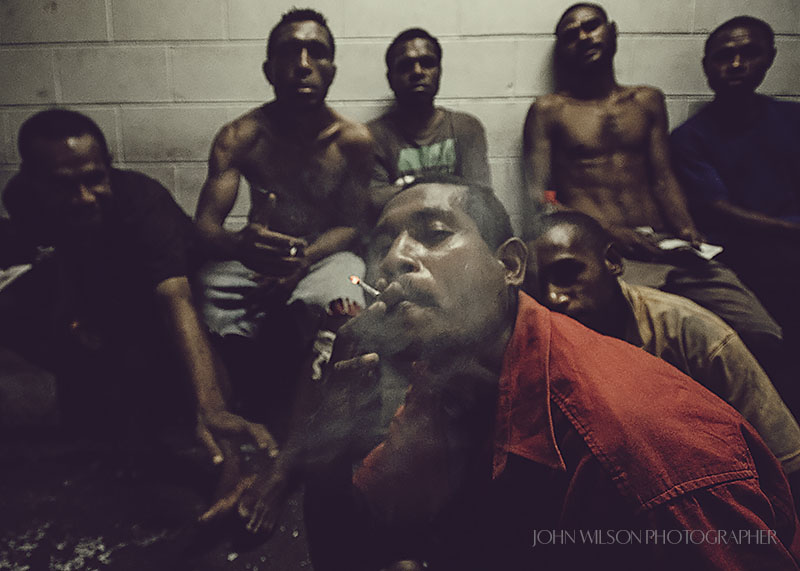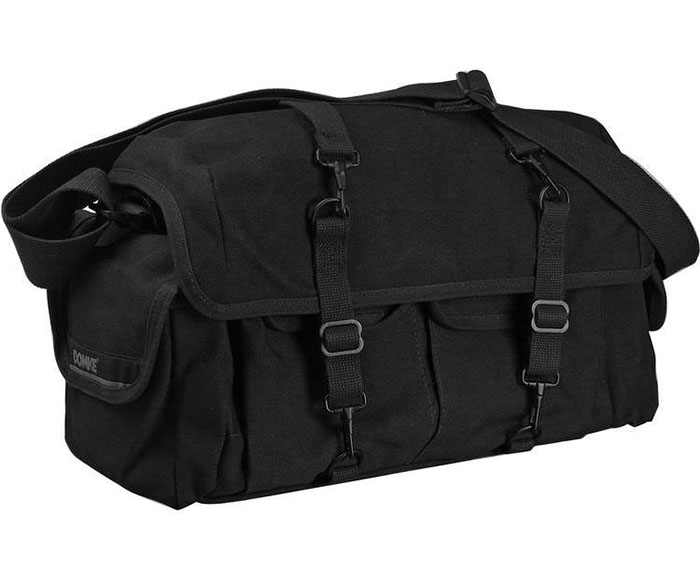
Boroko Jail, Papua New Guinea - Documentary Photography
By Australian Photojournalist John Wilson
I was photographing a story on law enforcement in Papua New Guinea (PNG) in the southwest Pacific when I made the photo above. Incredibly, I managed to gain access to the notorious jail at Boroko, in the capital Port Moresby, for some photography to support the story

Simply walking the streets of Port Moresby can be dangerous at times for foreign visitors. You only need to see the impressive security around expensive hotels in the capital to appreciate the security issues that exist in the city. If walking around the city could be dangerous then working inside the Boroko Jail and mixing freely with murderers, thugs and drug-fuelled inmates raised the danger stakes to the extreme.
Photographing inside the jail was challenging. Lighting conditions were poor at best and the dark grungy smoke-filled environment created a seedy atmosphere. I had to shoot with available light as I needed to keep a subdued profile amongst the men and I had minimal time to work. Slow shutter speeds and high iso settings were called for and I was constantly pushing the limits with how slow I could handhold the camera and maintain a sharp image and managing how high I could set the iso without digital noise (graininess) destroying the images. When I made these images the digital sensors in pro cameras were fairly good but low light shooting suffered. Modern camera sensors are far superior in the quality of the images they produce from what I used in this story.
Apart from the technical issues of shooting in the poorly lit environment, the other challenge was getting inmates to accept my presence. I had to develop a quick repour with my subjects or I would not be successful. This is a skill that is partly innate and partly learned. Throughout my career, I’ve had to learn how to manage my subjects just as much as I’ve had to manage the technical details of the photography. Repour building has actually saved my life on assignments over the years and allowed me access to people and their stories that I would not have had access to. Documentary Photojournalism is far more than making arty photos and a reasonable understanding of psychology is also required.


Working inside the jail was challenging as I was attempting to photograph subjects that were not sympathetic to my cause and lighting was at an absolute minimum. I knew there was a good picture to be made in the grungy, dimly lit setting with prisoners jammed into holding cells and I was constantly considering how much I could push my iso settings without destroying the images with too much digital noise and how slow I could get my shutter and still have a sharp image. The main photo of inmates was shot at 1000 iso at f4 and 1/15sec, Nikon D3x camera and Nikon 20mm f2.8 lens.

Some of this story was published in The Australian newspaper and I also shot a video story for the Seven Television Network in Australia.
Traveling in Papua New Guinea
Traveling in PNG can present difficulties for health and equipment once you move outside Port Moresby and major towns. Roads get very rugged in some areas and equipment can be smashed around if not stored correctly.
The tropical climate can be hot with high humidity and high rainfall. Lightweight clothing is best but don't forget to pack some rain gear for yourself and camera equipment. Port Moresby has the lowest average rainfall of around 1000mm per year while places such as Madang on the northeast coast have average rainfall in excess of 3000mm per year with some locations experiencing more than 4000mm per year.
if you expect to stay in the mountain regions such as Goroka it is wise to pack some warm clothing for the nights. Goroka is situated at just over 5000ft altitude and while average nighttime temperatures are around 16 degrees celsius, I've experienced much colder temperatures in some locations and having almost died from hypothermia in cold mountain conditions on another assignment I now always pack some type of warm clothing even if I'm visiting a mountain region for a day journey (You can read how almost succumbed to hypothermia in this article from Timor Leste).
Lightweight clothing which is easy to wash and dries quickly will be your best bet for travel in Papua New Guinea. I generally pack 2 pairs of footwear. Ive found it beneficial to pack a pair of good quality, low cut hiking shoes such as the Merrell Moab 2 Ventilator which is available in a waterproof version.

I also pack a pair of hiking sandals such as the TEVA FOERBAY which are great for travels in coastal areas, beaches and jumping into and out of boats.

I generally carried my basic camera kit in a Domke camera bag and most of the additional gear was kept in rugged pelican cases. Having gear brake in remote locations means going without rather than flying in replacements as it's just not practical or even possible in some locations.

The Domke camera bag I have used for about 20 years is the Domke F1X Camera Bag and to prove how durable these bags are I have only used 2 bags in 20 years and they have been dragged all over the world through jungles, deserts, mountains and been with me in war zones, natural and humanitarian disasters and many rugged situations, they've never let me down!
My Kit for this assignment:
- Two Nikon D3x camera bodies
- Sony Z7 video camera
- Two Sennheiser wireless microphones
- Manfrotto tripod with fluid head
- Nikon 20mm f2.8 lens
- Nikon 85mm f1.4 lens
- Nikon 180mm f2.8 lens
- Nikon 80-200mm f2.8 lens
- Nikon 300mm f2.8 lens
- Nikon 1.4x extender
- Nikon 2x extender
- Video light, 300 led
- 38inch translucent umbrella
- Two Nikon SB 800 flash units
- Domke F1X camera bag
- Lowepro Computer Trekker backpack
- Pelican cases x 2
- 13inch Macbook pro laptop
- BGAN satellite terminal

Terms & Conditions
Subscribe
Report
My comments